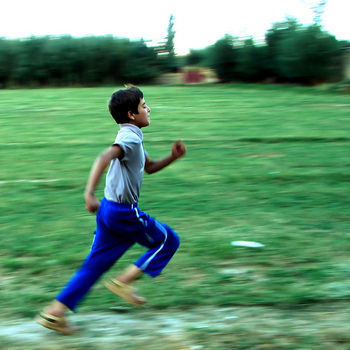Running from injuries: 3 tips for avoiding common runners' ailment

Photo by Flickr user Hamed Saber
Exercise is the absolute best thing for your health, better than any pill a doctor can prescribe. If it’s so good for us, then, why do so many injuries result? And how can you run and avoid an office visit?
For many of us, the answer is that we are too enthusiastic when we start. We are either unprepared (as in equipment, training, or warming up) or we try to do too much too fast. As a physician, I see the most running injuries when people (I am guilty of this too) are too eager and forget to gradually increase the difficulty of a workout. The following are some tips for recreational joggers to help prevent the most common running injuries. This is the first in a series of three articles on running injuries. This issue will focus on runner’s knee.
Runner’s knee is also known as patellofemoral pain syndrome or PFS, or chondromalatia patella. It describes inflammation and resultant roughness of the cartilage under the kneecap. I have heard sports medicine specialists say that all runners suffer this to some degree. The management of this condition centers on increasing quadriceps strength and flexibility. If you imagine your bent knee with the kneecap perched on top, and the quadriceps connected to the kneecap from above, you can probably visualize why the quadriceps is so important. Without flexibility (if it is too tight), the quadriceps will pull on the kneecap, resulting in painful friction and pressure. Without even strength, the quadriceps can pull the kneecap sideways, where it will rub the bone underneath, also resulting in friction, pressure, and pain.
There are some ways to help prevent the development of PFS, including:
1. Daily quadriceps stretching: I do this before each run, but the data actually does not prove that the timing before each workout matters that much. What does matter is that over time, your quadriceps becomes flexible enough that if you stand with your knees together, you can touch your heel to your rear end pretty easily.
2. Daily quadriceps strengthening exercises: Most people have more strength in the lateral (outer) quadriceps than in the medial (inner) quadriceps.
• To strengthen most effectively, stretch your leg in front of you and tip the toe outward.
• Then lift your leg until your foot is about 1 ft above the ground (about 15 degrees, no more than 30 degrees).
• Now, slowly move your leg laterally (outward) about 1 foot, then back in, and then gently set it down. This is one repetition.
The outward movement forces you to keep the leg slightly lifted a bit longer, and several slow repetitions are quite effective at strengthening the inner quadriceps. A good goal would be about 30 repetitions on each side a day.
3. Make sure running shoes fit well and have not broken down: A general rule of thumb is when you have accumulated 300 to 400 miles total - less (sooner) if you are big or run on hard surfaces. Many people find that every 6 months is easier to remember. Some people can go longer, some less. There is some debate about running shoes with cushion and support versus running barefoot or as close to it as possible.
Either way, the most important thing as that whenever you are trying something new or even resuming an activity after a long break, that you gradually work up your endurance. It is also very important that you have some protection so that stepping on a rock or piece of glass will not injure your foot!
Should pain develop, slow down or shorten your run. Ice the knee after activities (a frozen bag of peas or corn works well) for about 15-20 minutes at a time, over a washcloth or something to prevent direct freezing of the skin. Relative rest for a week or so is often a good idea, followed by very gradual return to activity. If you do not have a history of stomach ulcers or acid indigestion (or GERD), or kidney problems, or allergy, a brief period (5 to 7 days) of ibuprofen (600 mg, three times a day) might help. If you are at all unsure, consult with your doctor.
Of course, there are other running and overuse injuries that can occur which I have not touched on above. When in doubt, rest a few days and only once you are pain free, resume your exercise at a very easy distance and pace, only increasing by about 10% a week. These are very general guidelines. Serious athletes should see their doctor sooner.
Any time these tips do not seem to help, it is a very good idea to come in to your doctor and have a dedicated evaluation to aid healing and especially to prevent an injury from becoming something more serious. Next issue, read more about shin splints, and after that we will discuss plantar fasciitis.
This guest commentary Running from Injuries was written by one of the physicians on the Packard Health staff who practices with Dr. Rion, Holly Ross, M.D. Dr. Ross completed her residency at the University of Michigan Health System in 2009. Prior to that, Dr. Ross practiced family medicine in Vermont and from 2001-2004, she was a United States Navy flight surgeon. Dr. Ross sees patients of all ages and has a special interest in sports medicine, care of chronic medical conditions, women’s health, and the care of veterans and their families. Both she and Dr. Rion can be reached at info@packardhealth.org

